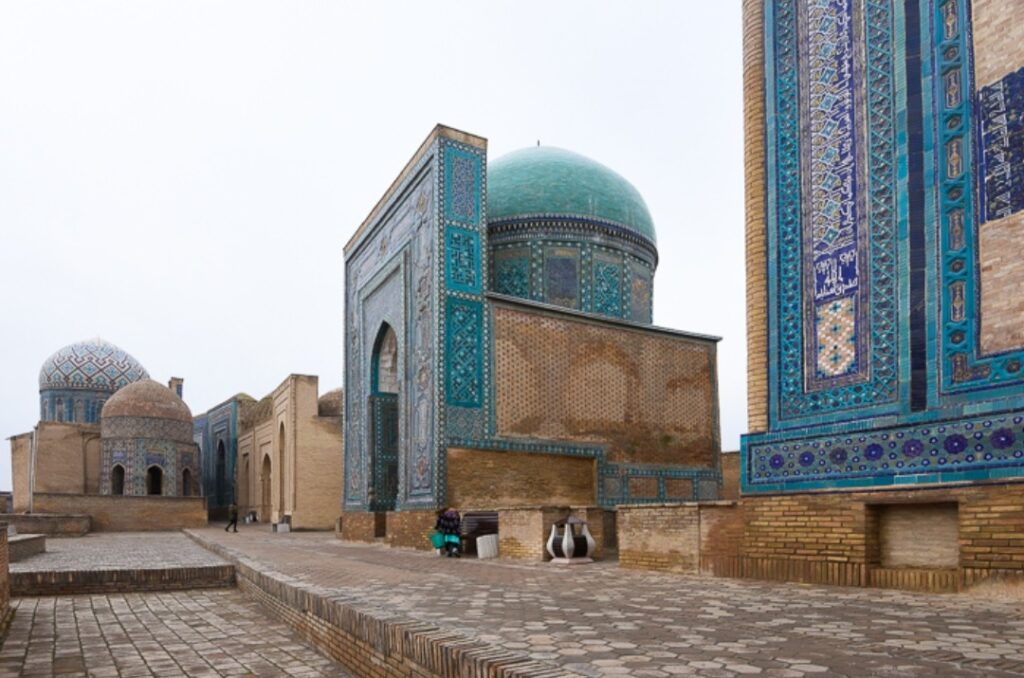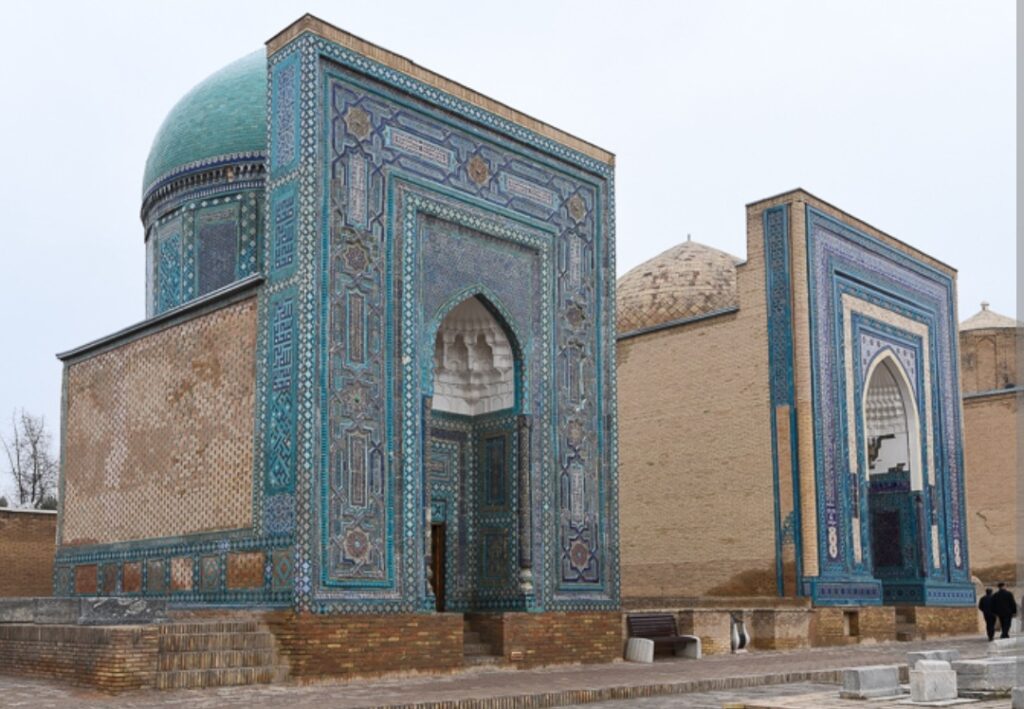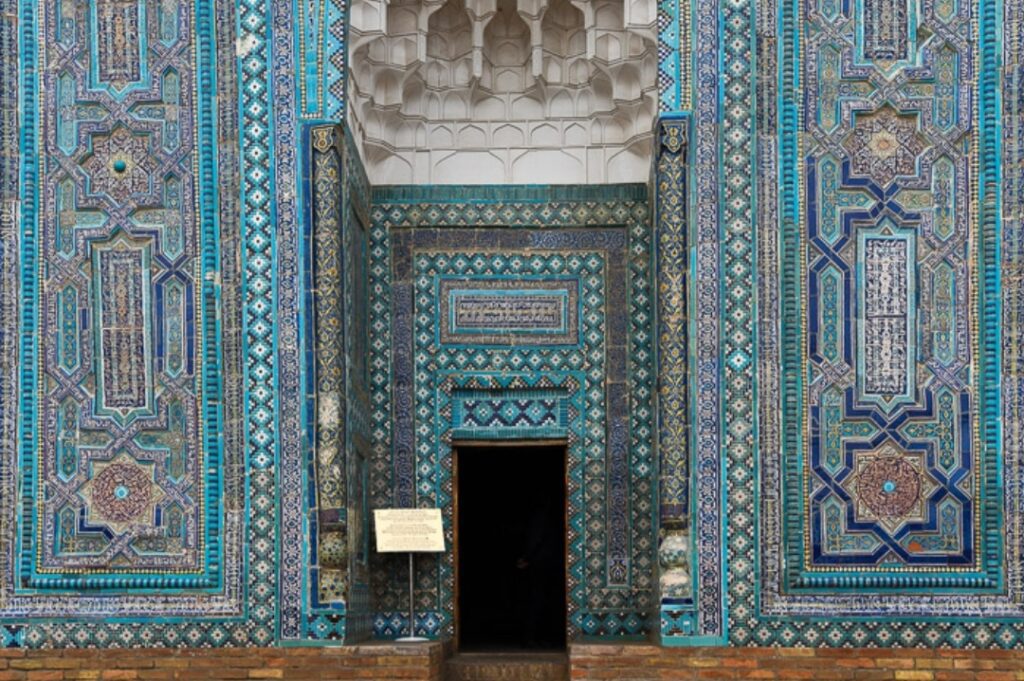Ali Nasafi tomb at Shah-i-Zinda, Samarkand

Tomb of Ali Nasafi is located on the west side of the alley of tombs within the Shah-i-Zinda necropolis, roughly halfway along the path.
It is one of a several dozen tombs built along the south side of a hill that formed the core of Afrasiyab, the city that preceded Samarkand prior to its destruction by the Mongols.
The name “Shah-i-Zinda”, or “The Living King”, refers to the legend that Qutham ibn Abbas, a cousin of the Prophet Muhammad who perished here in the first siege of Samarkand by Islamic forces, is not in fact dead, but descended into a well and remains the king of an underground paradise.
In honor of the saint, the site has attracted tomb building from the 11th through the 19th centuries, with many of its finest tombs built in the Timurid era .
Despite its designation as the “Ali Nasafi tomb”, nothing is known of who was buried here and what relation (if any) they had to the royal family of Timur.
The present name of the tomb is taken from an inscription at the base of the door jamb within the pishtaq, which attributes the tomb’s construction to a certain ostad (master artisan) Ali Nasafi, whose surname indicates the likely hometown of Karshi in what is now central Uzbekistan.
Although not included in the tomb’s present name, another ostad named Ali Tuki-kub left his signature on the opposite side of the door jamb in the same position. In the absence of further information, it is reasonable to assume that the two masters were equal participants in the execution of the tomb, as they both used the same titles (ostad) and inscribed their names in similar locations on opposite sides of the entrance.
The iconography of the tomb’s richly decorated pishtaq and interior surfaces provides a wealth of calligraphic samples in Arabic, mostly written in square Kufic script.
These mostly consist of verses from the Quran such as Sura 112 “The Unity”, Sura 114 “The Men”, and the entirety of verse 255 from Sura 2:Allah – there is no deity except Him, the Ever-Living, the Sustainer of [all] existence. Neither drowsiness overtakes Him nor sleep. To Him belongs whatever is in the heavens and whatever is on the earth. Who is it that can intercede with Him except by His permission? He knows what is [presently] before them and what will be after them, and they encompass not a thing of His knowledge except for what He wills. His Kursi [throne] extends over the heavens and the earth, and their preservation tires Him not. And He is the Most High, the Most Great.
As these verses are drawn directly from the Quran, they do not provide any useful information regarding the tomb’s occupant, other than that he/she was a Muslim. The only calligraphy that suggests more detail are the names of the twelve imams inscribed within several of the 8-sided star motifs on the front of the pishtaq. It may be an indication that the occupant had Shi’ite affiliations or was sympathetic to Shi’ite beliefs.
Beyond that, nothing written on the tomb brings its occupant into closer focus. It remains possible that such identifying information once existed on the tomb but was located in one or more areas that did not survive the passage of time.
The present “complete” appearance of the tomb is deceptive, as roughly 40% of the facade’s tile work are recent restorations, albeit of excellent quality.
The historians Soustiel and Porter suggest the monument was erected in two phases from the 1360s to the 1380s. The first phase involved the plan of the tomb which is similar to others from that era. Also, the specific use of buff bricks and turquoise key motifs is emblematic of the prevailing style of the 1360s. In contrast, the interior decoration and main facade are clearly of a more advanced nature and reflect techniques and motifs commonly used in the 1380s.
For example, Lisa Golombek notes that “the technique of painting tiles with a wide-ranging palette, including low-fire pigments such as red and gold, enjoyed a brief period of popularity in the region” (Golombek, p. 145), and notes that Ali Nasafi tomb is a relevant example of this short-lived trend.
Ultimately, this suggests the occupant was a person of some stature if construction of the tomb was maintained over a period of 20 to 30 years. Alternatively, it remains possible that the original tomb of the 1360s was never completed (and its occupant interred elsewhere), and the two osted were retained in the 1380s to complete its decorative treatment for another occupant.
One significant unknown is the state of the outer dome in this chronology: as the dome collapsed long ago (fortunately, not damaging the inner dome with its splendid ceiling), it is impossible to say what sort of decoration was used and to what extent it had been completed when the two masters began their work.




